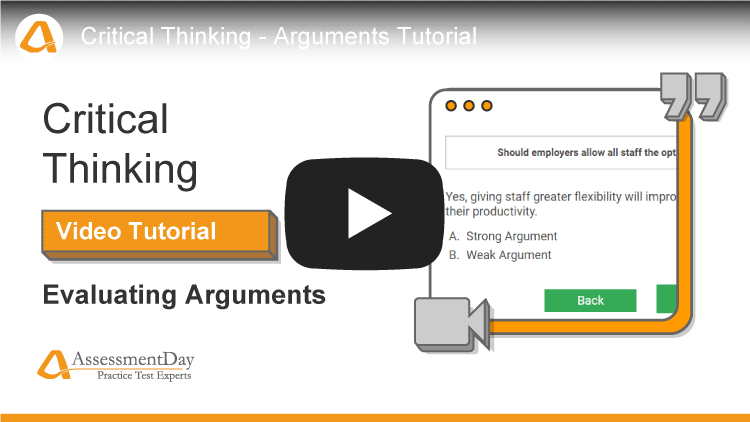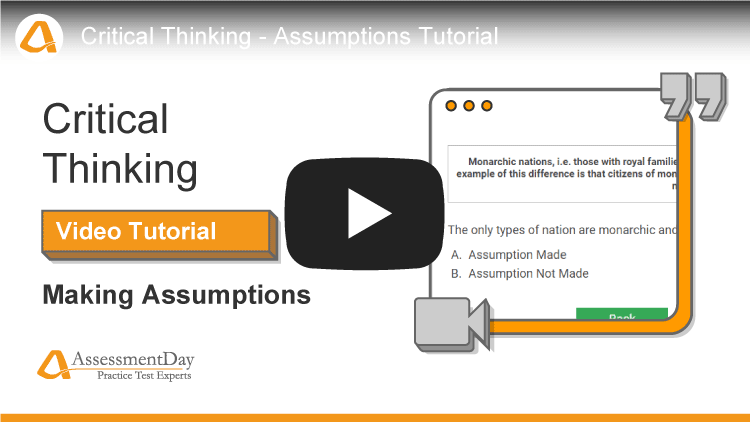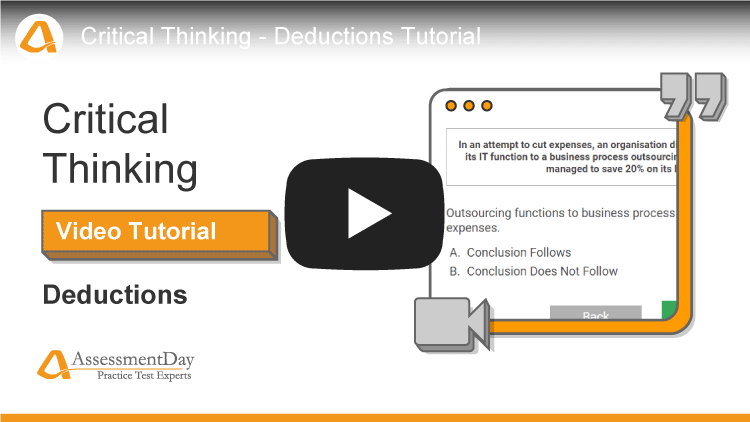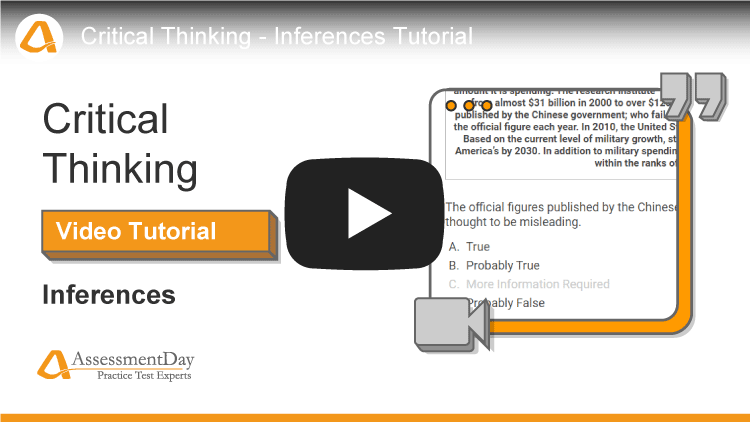Watson Glaser Critical Thinking Practice Tests and Advice
Critical thinking tests are high-level aptitude tests, with the Watson-Glaser being the most common.



Updated:
Page contents:
Jump to:- What is a critical thinking test?
- Critical thinking test format
- Watson Glaser critical thinking explained
- Critical thinking arguments tutorial
- Free Watson Glaser practice tests
- Critical thinking assumptions tutorial
- What does a critical test measure?
- Critical thinking deductions tutorial
- Most popular critical thinking tests
- Critical thinking inferences tutorial
- How to pass Watson Glaser test
- Watson Glaser FAQs
Looking to hire?
We recommend Test Partnership for companies seeking reliable hiring tests.

What is a critical thinking test?
A critical thinking test is used to assess your ability to logically analyse assumptions, arguments, deductions, inferences and interpreting information. Critical thinking can be defined as ‘the ability to consider a range of information derived from many different sources, to process this information in a creative and logical manner, challenging it, analysing it and arriving at considered conclusions which can be defended and justified’ (Moon, 2008).
Critical reasoning tests, also known as critical thinking tests, are psychometric tests commonly used in graduate, professional and managerial recruitment. These high-level analytical test are most commonly encountered in the legal sector, but other organisations such as the Bank of England also use them as part of their selection process.
If we lack critical thinking skills, it is possible to be misguided into believing that an argument is strong, when in actual fact there is little evidence to support it. Critical thinking skills therefore include the ability to structure a sound, solid argument, to analyse and synthesise available information, and to make assumptions and inferences. Critical thinking skills are also about being able to evaluate the information and draw conclusions that can be supported.
Critical thinking test format
Your critical thinking test may be pencil and paper or, more likely, it may be administered online. Which one you take will often depend on the format and the structure of the recruitment process. The questions will be multiple choice format and will usually be administered under time constraints.
Common test formats are as follows:
- 40 questions - 30 minutes
- 80 question - 60 minutes
Once you understand the format of your test, you are much more likely to perform better. Practice is the best way to maximise your chances of test success.
Watson Glaser critical thinking appraisal explained
By far the most common type of critical thinking test is the Watson-Glaser Critical Thinking Appraisal (W-GCTA) which is published by TalentLens. You can visit their official site here: Watson Glaser. With over 85 years' worth of development, the Watson-Glaser Critical Thinking Appraisal is the most popular measure of critical thinking ability. The test is most commonly used by law firms, which is understandable as the abilities measured by the W-GCTA are good predictors of future success in roles which require clarity of understanding from multiple perspectives and the ability to reason with fact versus assumption.
The Watson-Glaser Thinking Appraisal (W-GCTA) is one of the main evaluating tools for cognitive abilities in professionals, since it measures critical thinking. It is seen as a successful tool to predict job success, as well as being used to select good managers and finding possible future leaders. It is also used in order to select the right person for a specific job role, especially for careers in the law.
Did You Know
The most recent revision of the W-GCTA was published in 2011 with notable improvements being better face validity and business-relevant items, scoring based on Item Response Theory (IRT), updated norm groups, and an online retest which can be used to validate a paper and pencil test result.
The W-GCTA was originally developed by Goodwin Watson and Edward Glaser. The W-GCTA measures the critical skills that are necessary for presenting in a clear, structured, well-reasoned way, a certain point of view and convincing others of your argument. The test questions are looking at the individual’s ability to:
- Make correct inferences
- To recognise assumptions
- To make deductions
- To come to conclusions
- To interpret and evaluate arguments
Critical thinking arguments tutorial
The following video features Ben explain how to answer an arguments-style question from a critical thinking test:

Free Watson Glaser practice tests
Free Critical Thinking Test
FreeWe have broken down a critical thinking test into the different sections. You can try each section or take the full test (86 questions, 60 minutes).
Free Critical Thinking Test
Try here a new shorter critical thinking test directly from Test Partnership!
Critical Thinking Test 1
Premium- 40 questions
- 40 mins
Critical Thinking Test 2
PremiumCritical Thinking Test 3
PremiumCritical Thinking Test 4
PremiumCritical thinking assumptions tutorial
The following video features Ben explain how to answer an assumptions-style question from a critical thinking test:

Start practising quality tests with a free account
Practice makes perfect
- Learn from detailed solutions
- Track your progress

What does a critical thinking test measure?
Critical thinking tests assess your ability to logically analyse assumptions, arguments, deductions, inferences and interpreting information. You will be given a passage of information which may contain a mixture of verbal and numerical data, and will be provided with a statement which requires the candidate’s critical assessment of how true that statement is based on the above passage.
The Watson and Glaser Critical Thinking Appraisal contains five sections which are specially designed in order to find out how good an individual is at reasoning analytically and logically. There are five sections:
- Assumptions: In these questions a statement will be presented and the candidate will have to decide if an assumption has been made in making the statement. For example in the statement “only people earning a high salary can afford a fast car” it is assumed that fast cars cost more than not fast cars (this is just one of many assumptions implicit in the statement). An assumption is something someone effectively takes for granted. Statements are given for the individual to read and they are then followed by several proposed assumptions. The candidate has to select whether an assumption has or has not been made.
- Analysing arguments: Candidates will be provided with a given scenario i.e. “Should the government pay student’s tuition fees?” They are subsequently provided with a list of arguments for or against the scenario presented. The candidate will need to assess if each argument is strong or weak, based on how relevant it is and how well it addresses the question. The argument is considered to be strong if it directly relates to the question or statement, and weak if it is not directly related to the question or statement.
- Deductions: Candidates will be provided with a passage of information and candidates will need to evaluate a list of deductions made based on that passage. If one cannot deduce a particular statement from the passage, then that deduction does not follow, and the candidate must select which deductions follow and which do not follow. The answer must be entirely based on the statements made and not on conclusions made from one’s own knowledge.
- Inferences: In this section candidates will be provided with a passage of information on a scenario. A subsequent list of possible inferences will follow, and candidates will be asked to rate if they are true, false, possibly true, possibly false or whether it is not possible to say based on the information in the passage.
- Interpreting Information: A paragraph of information will be provided to the candidate, with a list of possible conclusions. Candidates will need to interpret the information in the paragraph and decide if each conclusion follows based on the presented information. Once again the decisions must solely be based on the information given.
With so many sections, each having their own instructions and guidelines, it can be tough to become confident on all areas.
Survey results
We asked critical thinking test takers what they found was the most difficult section of a critical thinking test. 35% of them believed 'assumptions' to be the most difficult. You can see the full results below:

Critical thinking deductions tutorial
The following video features Ben explain how to answer a deductions-style question from a critical thinking test:

Most popular critical thinking test publishers
There may be variations in your test depending on the test publisher you have for your critical thinking test.
Survey results
We analysed a sample of critical thinking tests to discover the most popular test publishers. It was found that 77% of critical thinking tests were published by Watson Glaser.

Here is a list of critical reasoning tests on the market at present, which candidates may be likely to encounter for recruitment, selection or development:
- Watson Glaser Critical Thinking Appraisal: The W-GCTA is the most widely-used critical reasoning test on the market, and the one candidates are most likely to encounter.
- SHL Critical Reasoning Test Battery: The SHL Critical Reasoning Test Battery is a collection of 60 critical reasoning questions with varying difficulty depending of the level of candidate. This test has a time limit of 30 minutes.
- Cornell Critical Thinking Assessment: The Cornell Critical Thinking Assessment is a test primarily used in educational settings. There are two versions of this test, one for children and one for adults. This test may be used for entry onto particular degree courses or for recruitment/development purposes.
- Cappfinity Critical Reasoning Test: This assesses your problem solving and decision making skills. Its topics have similarities with the Watson Glaser.
- Test Partnership Concepts Critical Thinking Test: This also shares some similarities with the Watson Glaser. Test Partnership assesses the classic aspects of critical thinking with a modern candidate experience.
Critical thinking inferences tutorial
The following video features Ben explain how to answer an inference-style question from a critical thinking test:

How to pass Watson Glaser test - critical thinking tips
Here is some general advice to help you learn how to improve your Watson Glaser score:
- Only use the information contained in the test: When reading the passages of information within the test, your first instinct may be to use general knowledge or your own personal experience. Critical reasoning tests are not tests of what you think; they are tests of how you think. You will not be required to utilise any prior knowledge when answering a question, and at times the correct answer will completely contradict what you know to be true based on your own knowledge, but is true in the context of the passage.
- Read the instructions thoroughly: Critical reasoning tests will require numerous separate types of logical reasoning, and reading the instructions will inform you of how to answer questions correctly. For example if a question requires you to evaluate the strength of an argument, the instruction page will inform you what constitutes a strong or weak argument. Take ample time to ensure you know how to answer questions regardless of any time limits.
- Pay attention to time limits: Due to the complex nature of critical reasoning tests, there will often be no time limits or there will be generous time limits. Candidates are advised to use this to their advantage and take plenty of time when reading, evaluating and answering. An easy mistake to make is treating this type of test like a verbal or numerical reasoning test and answering questions as quickly as possible. Rushing through a critical thinking test may lead to candidates missing key points, and answering incorrectly as a result.
- Understand logical fallacies: Understanding logical fallacies is an important part of the test, and researching the difference between sound and fallacious logic can help maximise performance on a critical reasoning test. A fallacy is an error in reasoning due to a misconception or a presumption, and an argument which employs a formal fallacy, logical fallacy or a deductive fallacy in its reasoning becomes an invalid argument. Researching the different types of fallacy (i.e. red herring argument, straw man argument, confusing correlation and causation etc.) can help you identify them in the test and therefore answer the question correctly.